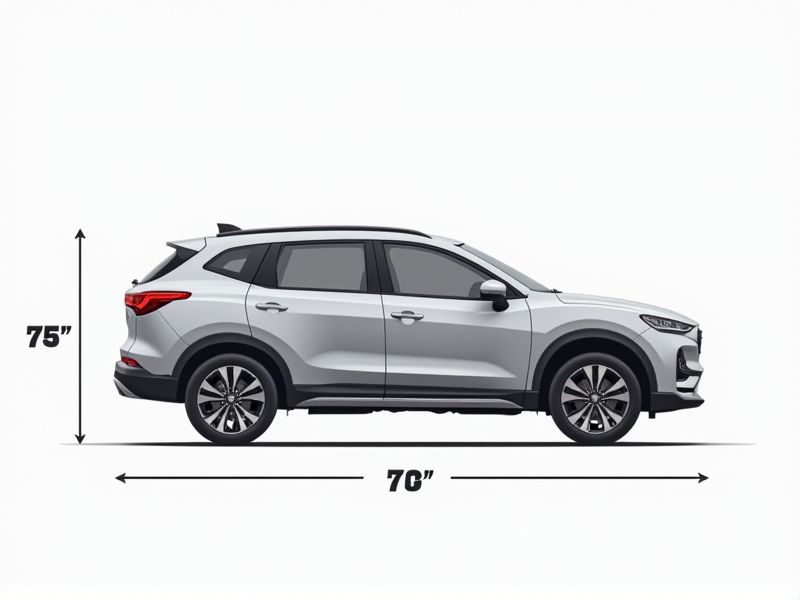
SUVs (Sport Utility Vehicles) vary in size, but standard dimensions for a midsize SUV generally range from 185 to 195 inches in length, 75 to 80 inches in width, and 66 to 72 inches in height. Knowing these averages is useful when considering garage space, parking, or comparing vehicles. For example, a popular midsize SUV like the Toyota Highlander is about 194 inches long, 76 inches wide, and 68 inches tall. Checking a manufacturer's specifications is always recommended, as dimensions can differ slightly between models and trims.
Vehicle Width
The standard vehicle width for most SUVs ranges between 70 to 80 inches, contributing to their spacious interiors and stable handling. A wider body enhances passenger comfort, allowing for three rows of seating and increased cargo capacity, often exceeding 60 cubic feet. On the other hand, a 74-inch width strikes a balance between robustness and maneuverability, making it suitable for urban driving. When considering an SUV, it's essential to evaluate how width impacts your driving experience and parking ease.
Vehicle Length
When selecting an SUV, consider that the standard vehicle length typically ranges from 4,200 mm to 5,000 mm. A longer SUV often provides increased passenger space and enhanced cargo capacity, which can be crucial for family road trips. Meanwhile, compact models, usually around 4,200 mm to 4,500 mm, offer better maneuverability and efficiency, appealing to urban drivers. Your choice in vehicle length can significantly impact comfort, practicality, and overall driving experience.
Vehicle Height
The standard height for SUVs generally ranges between 60 and 75 inches, significantly impacting their off-road capabilities and overall driving experience. A higher vehicle height often translates to improved ground clearance, which is crucial for navigating rough terrain and avoiding obstacles. Many SUV models feature adjustable suspension systems that allow you to customize the height, enhancing versatility in various driving conditions. By prioritizing vehicle height, manufacturers ensure that drivers enjoy a commanding view of the road, contributing to overall safety and comfort.
Wheelbase Length
The wheelbase length of SUVs plays a critical role in determining stability, ride quality, and interior space. Most modern SUVs feature a wheelbase ranging from 100 to 120 inches, providing a balance between maneuverability and comfort. A longer wheelbase typically enhances stability at high speeds, while a shorter wheelbase allows for easier navigation in tight spaces. When considering an SUV, prioritize models with an optimal wheelbase to meet your driving needs and preferences.
Ground Clearance
Ground clearance in SUVs typically ranges from 6 to 12 inches, significantly impacting off-road capabilities and driving comfort. Models designed for rugged terrains, like the Jeep Wrangler, often feature clearances exceeding 10 inches, allowing for better maneuverability over obstacles. Higher ground clearance also contributes to improved visibility, providing drivers with a clearer view of the road ahead. When choosing an SUV, it's essential to consider how ground clearance aligns with your driving needs, whether for daily commuting or off-road adventures.
Cargo Space Volume
Cargo space volume is a critical factor influencing SUV choices, with leading models offering between 30 to 80 cubic feet of storage capacity. When evaluating options, consider the Volkswagen Tiguan, which boasts approximately 37.6 cubic feet behind the second row, expandable to 73.5 cubic feet with the seats folded down. The Honda CR-V offers slightly more, reaching up to 75.8 cubic feet, making it an excellent choice for families or adventurers seeking ample storage. Your selection should align with lifestyle needs, whether for everyday errands or extended road trips.
Front/Rear Legroom
Front legroom in SUVs typically ranges from 40 to 45 inches, offering ample space for driver and passenger comfort. Rear legroom varies, often between 36 to 42 inches, ensuring that backseat passengers can enjoy a pleasant ride. Popular models like the Ford Explorer and Honda CR-V excel in these dimensions, enhancing the overall family experience. When choosing an SUV, consider these measurements, as they significantly influence passenger satisfaction during long journeys.
Headroom Space
Headroom space is a crucial factor in evaluating the comfort of an SUV, with many models offering between 39 to 41 inches of vertical clearance. This dimension directly affects the overall driving experience, as ample headroom can enhance user comfort for both the driver and passengers during longer trips. When comparing SUVs, consider that models featuring adjustable seating options can provide an additional 2 to 3 inches of personalized headroom. Prioritizing this aspect can significantly impact your decision, especially if you or your passengers are taller than average.
Seating Capacity
Most SUVs typically offer a seating capacity ranging from five to eight passengers, making them ideal for families and group travel. The interior space can be adjusted with versatile configurations, including foldable rear seats, which enhance cargo flexibility. In 2023, many models are designed with third-row seating options, catering to those needing extra room without sacrificing comfort. When selecting an SUV, consider your seating needs to ensure it aligns with your lifestyle and travel requirements.
Turning Radius
The turning radius of an SUV typically ranges between 33 to 40 feet, significantly impacting maneuverability in urban environments. A smaller turning radius allows for easier navigation in tight spaces, making it advantageous for city driving. Notably, models like the Honda CR-V offer a turning radius of approximately 36.5 feet, enhancing your ability to handle sharp corners. Understanding this aspect can help you select an SUV that meets your driving needs and preferences.
